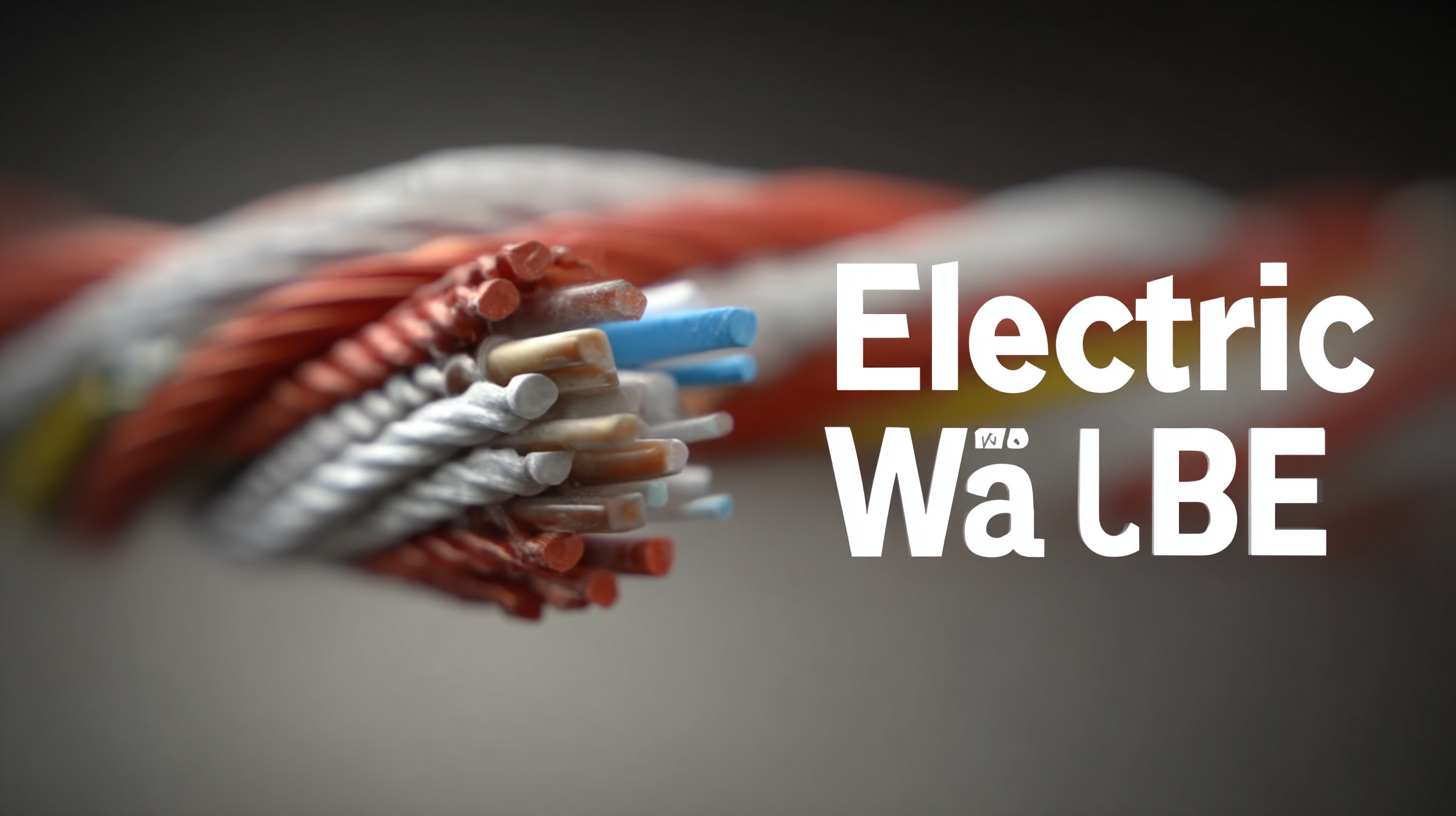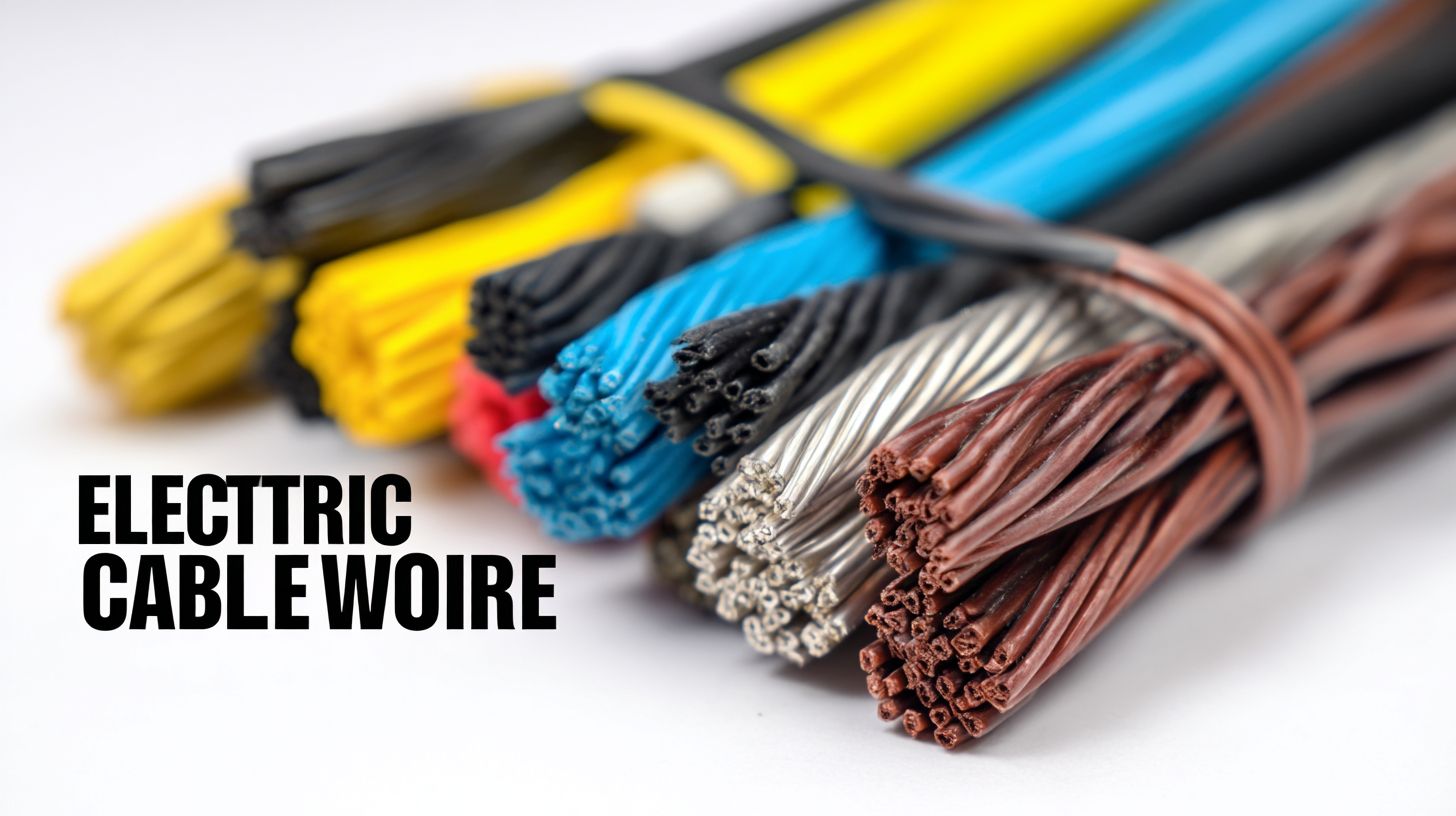The Ultimate Guide to Sourcing the Best Electric Cable Wire for Your Business Needs
In today's rapidly evolving industrial landscape, selecting the right Electric Cable Wire is crucial for ensuring safety, efficiency, and longevity in various applications. The global electric wire and cable market is projected to reach approximately $300 billion by 2025, driven by an increasing demand for energy-efficient solutions across sectors such as construction, automotive, and telecommunications.

As industries strive to meet regulatory standards and enhance operational performance, understanding the diverse types and applications of electric cable wire becomes paramount. From delivering power seamlessly in residential settings to supporting complex wiring systems in commercial infrastructures, the versatility of electric cable wire cannot be overstated. This guide aims to equip businesses with the insights needed to make informed sourcing decisions, outlining the specific industry applications and the types of electric cable wire that fit their unique requirements.
Understanding Electrical Cable Types and Their Applications for Industry 2025
When navigating the world of electric cables, understanding the various types and their applications is crucial for any business aiming to meet industry demands in 2025. Different industries require specific cable types, such as low voltage, medium voltage, and high voltage cables, each designed to handle varying levels of electrical load and environmental conditions. For example, low voltage cables are ideal for residential and commercial applications, while medium and high voltage cables are predominantly used in power distribution and transmission systems.
**Tip:** Always assess the specific requirements of your project, including voltage, amperage, and environmental exposure. This assessment will guide you toward selecting the most suitable type of electrical cable.
In addition to the cable types, consider the material composition. Copper and aluminum are the most common conductors, with copper offering better conductivity and aluminum being lighter and less expensive. Choosing the right material can significantly impact the efficiency and longevity of your electrical installations.
**Tip:** Ensure that you check the insulation rating and environmental compatibility of the cable to guarantee safety and compliance with industry standards.

Key Factors Influencing Electric Cable Selection for Business Efficiency
When selecting electric cable wire for business operations, understanding key factors that influence efficiency and performance is essential. One such factor is the specific application of the cable. Different environments, such as industrial settings, residential areas, or specialized installations like electric underfloor heating, require unique attributes in their cabling solutions.
For instance, the growing popularity of electric underfloor heating systems has driven a significant increase in global cable sales, projected to reach 10.51 billion Yuan in 2023. This shift emphasizes the importance of sourcing cables that are compatible with the latest technologies to meet market demands effectively.
Another critical aspect to consider is the regulatory landscape and available incentives. Various governments are implementing policies that promote energy efficiency and environmental sustainability, which can directly impact cable selection. Through tax reductions and subsidies, businesses can gain financial advantages while investing in high-quality, eco-friendly electric cable options. These factors not only contribute to compliance with regulations but also enhance operational efficiency and long-term savings, making informed sourcing choices vital for any business looking to thrive in a competitive market.
Market Trends: Projected Growth in the Electric Cable Industry Through 2025
 The electric cable industry is witnessing significant projected growth, especially in the High Voltage Direct Current (HVDC) cable segment. The market size for HVDC cables is set to reach approximately $199.36 million in 2024, with expectations to expand to $215.53 million by 2025. This trend highlights the increasing demand for efficient energy transmission solutions that cater to the rising global energy needs.
The electric cable industry is witnessing significant projected growth, especially in the High Voltage Direct Current (HVDC) cable segment. The market size for HVDC cables is set to reach approximately $199.36 million in 2024, with expectations to expand to $215.53 million by 2025. This trend highlights the increasing demand for efficient energy transmission solutions that cater to the rising global energy needs.
Moreover, the automotive wire and cable materials sector also shows promising growth, with an estimated market size of $21.116 billion in 2025, anticipated to climb to $28.456 billion by 2033. The compound annual growth rate (CAGR) for this market is projected at 3.8%, reflecting the evolving automotive technologies that necessitate advanced wiring solutions to support electric and hybrid vehicles.
In the wider context, the global electrical equipment market is expecting substantial expansion, with projections indicating a rise from $166.02 billion in 2025 to $332.6 billion by 2032, which corresponds to a robust CAGR of 10.4%. These trends demonstrate the electric cable industry's resilience and its critical role in supporting the growing infrastructural demands across various sectors, particularly in energy and automotive advancements.
Innovative Technologies Impacting Electric Cable Production and Performance
Innovative technologies are reshaping the landscape of electric cable production and performance, ultimately influencing the choices of businesses in their sourcing decisions. The advent of advanced materials like low-smoke zero-halogen (LSZH) compounds has significantly enhanced fire safety and reduced environmental impact. According to a recent report from MarketsandMarkets, the electric cable market is projected to grow at a CAGR of 7.4% between 2021 and 2026, with innovations in smart cables driving a substantial portion of this growth. These smart cables integrate sensors to monitor current, temperature, and even wear and tear, allowing for preemptive maintenance and increased safety.
Tip: When sourcing cables for your business, prioritize suppliers who utilize these innovative materials and technologies. They not only meet safety standards but also offer enhanced long-term performance, ultimately reducing costs related to maintenance and replacements.
Moreover, the energy sector's shift towards renewable sources has prompted the development of cables designed for higher efficiency. For instance, high-voltage direct current (HVDC) cables are becoming increasingly popular for long-distance energy transmission due to their superior efficiency over traditional AC cables. According to the International Energy Agency, the demand for HVDC solutions is expected to reach USD 20 billion by 2025.
Tip: Stay updated with new technologies and consider integrating renewable energy solutions to boost your overall efficiency. This not only improves your operational performance but can also position your business as environmentally responsible in a competitive market.
The Ultimate Guide to Electric Cable Wire Performance
This bar chart illustrates the performance ratings of various types of electric cable wire based on their material and insulation properties. Copper wire leads in performance, followed closely by fiber optic cables, while PVC cables show lower ratings due to their material limitations.
Sustainability in Electric Cable Manufacturing: Industry 2025 Best Practices
Sustainability has become a cornerstone of electric cable manufacturing, pushing the industry toward greener practices that not only meet regulatory requirements but also appeal to environmentally conscious customers. As we approach 2025, effective sustainable strategies will focus on reducing waste, enhancing energy efficiency, and utilizing eco-friendly materials. Companies are increasingly adopting circular economy principles, wherein materials are reused and recycled, significantly minimizing environmental impact.
Innovations in manufacturing processes are also crucial. The integration of renewable energy sources, such as solar and wind, into production facilities can drastically cut down carbon footprints. Moreover, companies are exploring biodegradable polymers and advanced composites to replace traditional, less sustainable materials. This shift not only helps in lowering emissions but also addresses the growing demand for products that contribute to a more sustainable planet. By implementing these best practices, businesses can not only remain competitive but also lead the charge towards a more sustainable future in electric cable manufacturing.
The Ultimate Guide to Sourcing the Best Electric Cable Wire for Your Business Needs - Sustainability in Electric Cable Manufacturing: Industry 2025 Best Practices
| Category | Material Type | Sustainable Practices | Recyclability (%) | Electric Conductivity (S/m) | Usage Applications |
|---|---|---|---|---|---|
| Low Voltage | Copper | Renewable Energy Sources | 85% | 5.96 × 10^7 | Residential Wiring |
| Medium Voltage | Aluminum | Energy Efficient Manufacturing | 70% | 3.77 × 10^7 | Industrial Applications |
| High Voltage | Copper | Life Cycle Assessment | 90% | 5.96 × 10^7 | Power Transmission |
| Specialty Cable | Fiber Optic | Biodegradable Insulation | 60% | N/A | Telecommunications |
